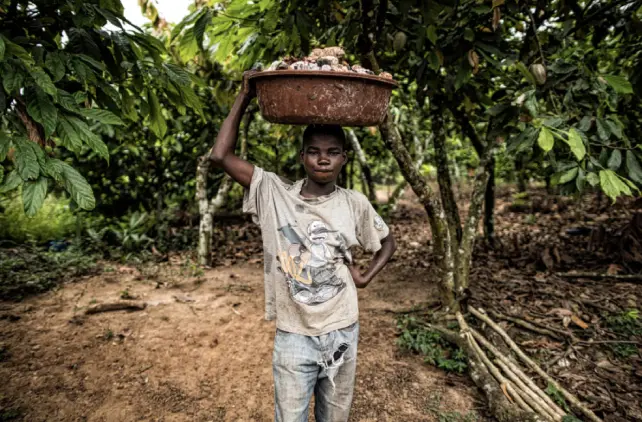
By Stephanie Bechara
Chocolate, a product of the cocoa bean, remains one of the world’s most popular snacks. In 2020, 268.09 million Americans alone consumed chocolate and other candies (Wunsch, 2021). While chocolate may be a joy stimulant when consumed in moderation, the conditions faced by the people who grow cocoa may not be as joyful.
The cocoa sector faces not one, but many problems that threaten the sustainability of cocoa harvests including gender inequality, deforestation, widespread adversity, and most importantly: child labor and forced labor.
Western African countries remain the largest suppliers of cocoa, a commodity crop mainly grown for export, with Ghana and the Ivory Coast supplying around 70% of cocoa globally (Foodispower, 2022). After being grown and harvested, the cocoa beans are then purchased by some of the largest chocolate manufacturers in the world (Hershey’s, Mars and Nestle amongst many others); these are the same companies that pledged to eradicate child labor and slavery more than 20 years ago through the Harkin-Engel Protocol (Whoriskey and Siegel, 2019).
Child labor, trafficking, and slavery on cocoa farms in Western African countries have been the subject of numerous articles and documentaries in the past couple of decades. Child labor is not limited to Ghana and the Ivory Coast; journalists and organizations have additionally located and exposed child labor in Nigeria, Sierra Leone, Guinea and Cameroon. Evidence of child slavery on cocoa farms has equally surged in Brazil, with cocoa workers facing similar precarious conditions as those working in Western African countries (Foodispower, 2022).
It is estimated that roughly 1.8 million children are currently engaged in hazardous work across cocoa plantations (The World Counts, n.d.). Mainly aged between 10 to 15 years old (and sometimes younger), children work as slaves in cocoa farms where they are usually underfed and face physical abuse; they are subject to forced labor so as to pay their family’s debts. Forced to work long hours (up to 14 years per day), child laborers work with sharp tools, agricultural chemicals and carry heavy loads (Foodispower, 2022).
Many children have reportedly been trafficked and taken away from their parents, only to never see them again. In the Ivory Coast alone, around 200,000 children are estimated to work in cocoa plantations and more than 30% of them do not attend school. The International Labor Organization (ILO) has coined this as “the worst form of child labor” (Foodispower, 2022).
Nearly 20 years have gone by since chocolate giants have pledged to end child labor, and they have again and again missed their deadline. The number of child workers continues to grow.
What can you do to support fair trade cocoa?
Choosing fairly traded cocoa and chocolate is crucial to promote the long-term sustainability of the cocoa industry, drive change, and work towards a child slavery free chocolate industry.
Find out more about Fairtrade cocoa here:
https://www.fairtrade.net/product/cocoa
Fairtrade Chocolate Companies:
https://www.thegoodtrade.com/features/fair-trade-chocolate
https://tonyschocolonely.com/us/en
References
Child labor and slavery in the chocolate industry. Food Empowerment Project. (2022, January). Retrieved June 2022, from https://foodispower.org/human-labor-slavery/slavery-chocolate/
Cocoa. Fairtrade International. (n.d.). Retrieved June 16, 2022, from https://www.fairtrade.net/product/cocoa
Ramnarace, C. (n.d.). Are there happy mood foods? WebMD. Retrieved June 16, 2022, from https://www.webmd.com/food-recipes/features/can-food-affect-my-mood
Slave free chocolate. Slave Free Chocolate. (n.d.). Retrieved June 16, 2022, from https://www.slavefreechocolate.org/
The dark side of chocolate. The world counts. (n.d.). Retrieved June 16, 2022, from https://www.theworldcounts.com/stories/child-labor-in-chocolate-industry
Walt, V. (2020, October 19). Big chocolate’s child-labor problem is still far from fixed. Fortune. Retrieved June 16, 2022, from https://fortune.com/2020/10/19/chocolate-child-labor-west-africa-cocoa-farms/
Whoriskey, P., & Siegel, R. (2019, June 5). Hershey, Nestle and Mars won’t promise their chocolate is free of Child labor. The Washington Post. Retrieved June 16, 2022, from https://www.washingtonpost.com/graphics/2019/business/hershey-nestle-mars-chocolate-child-labor-west-africa/
Wunsch, N.-G. (2021, May 17). Leading chocolate consuming countries worldwide 2017. Statista. Retrieved June 16, 2022, from https://www.statista.com/statistics/819288/worldwide-chocolate-consumption-by-country/
Cover Photo: Benjamin Lowi; retrieved from https://content.fortune.com/wp-content/uploads/2016/02/cho03_b.jpg?quality=80
